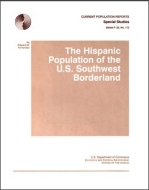The Hispanic Population of the U.S. Southwest Borderland
The Hispanic Population of the U.S. Southwest Borderland
Preface
The abundance of information generated by the 1980 Census of Population has highlighted many matters of importance to the Nation. Among them is the uniqueness of the U.S. southwest borderland. By specifying the growth levels of the borderland during the 1970-80 decade (and the border metropolitan areas from 1980-1985) and analyzing information on selected social, economic, and demographic characteristics of the U.S. population in the area bordering Mexico, this report attempts to show some of the causes that make the “borderland” area unique.
The southwest borderland, as covered in this report, is unique because of its enormous population growth, especially in Hispanics, that occurred during the 1970-80 decade and, which evidence shows, continued into the 1980's, and the differences in characteristics between the populations in the border areas and those away from the border.
The text and tables in this report compare Hispanic and non-Hispanic population growth in the border and nonborder regions of the border States, and in the metropolitan areas “close” to the border. The size, distribution, and type of Hispanic population in the border and non-border regions of each border State, and social, economic, and demographic characteristics of Hispanics and non-Hispanics in these regions are also discussed. Some of the compared characteristics include: age, sex, marital status, school enrollment, educational attainment, fertility, type and size of household, labor force status, occupation, family income, and poverty status.
Two conclusions are drawn from this analysis: (1) the distinctiveness of the U.S. southwest borderland area, and (2) the realization that this is caused, at least in part, by the large Hispanic population residing there.
Although most of the data studied below pertain to 1980, we expect that the relationships shown here will motivate more current analysis when 1990 census data become available.
A Note on Language
Census statistics date back to 1790 and reflect the growth and change of the United States. Past census reports contain some terms that today’s readers may consider obsolete and inappropriate. As part of our goal to be open and transparent with the public, we are improving access to all Census Bureau original publications and statistics, which serve as a guide to the nation's history.
Others in Series
Publication
Publication
Publication




